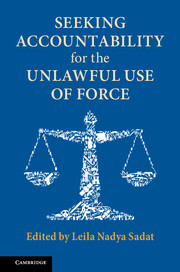Book contents
- Frontmatter
- Dedication
- Contents
- Notes on Contributors
- Foreword
- Preface
- Table of Cases
- Introduction
- PART I HISTORIC AND CONTEMPORARY PERSPECTIVES ON THE UNLAWFUL USE OF FORCE
- 1 The Status of Aggression in International Law from Versailles to Kampala – and What the Future Might Hold
- 2 Nuremberg and Aggressive War
- 3 The Tokyo International Military Tribunal and Crimes Against Peace (Aggression): Is There Anything to Learn?
- 4 The Just War in Ancient Legal Thought
- 5 Definitions of Aggression as Harbingers of International Change
- 6 International Humanitarian Law in an Age of Extremes: Unlawful Uses of Force by Non-State Actors
- PART II MECHANISMS FOR RESTRAINING THE UNLAWFUL USE OF FORCE AND ENHANCING ACCOUNTABILITY
- PART III THE ILLEGAL USE OF FORCE AND THE PROSECUTION OF INTERNATIONAL CRIMES
- PART IV IMAGINING A BETTER WORLD
- Epilogue
- Index
3 - The Tokyo International Military Tribunal and Crimes Against Peace (Aggression): Is There Anything to Learn?
from PART I - HISTORIC AND CONTEMPORARY PERSPECTIVES ON THE UNLAWFUL USE OF FORCE
Published online by Cambridge University Press: 21 May 2018
- Frontmatter
- Dedication
- Contents
- Notes on Contributors
- Foreword
- Preface
- Table of Cases
- Introduction
- PART I HISTORIC AND CONTEMPORARY PERSPECTIVES ON THE UNLAWFUL USE OF FORCE
- 1 The Status of Aggression in International Law from Versailles to Kampala – and What the Future Might Hold
- 2 Nuremberg and Aggressive War
- 3 The Tokyo International Military Tribunal and Crimes Against Peace (Aggression): Is There Anything to Learn?
- 4 The Just War in Ancient Legal Thought
- 5 Definitions of Aggression as Harbingers of International Change
- 6 International Humanitarian Law in an Age of Extremes: Unlawful Uses of Force by Non-State Actors
- PART II MECHANISMS FOR RESTRAINING THE UNLAWFUL USE OF FORCE AND ENHANCING ACCOUNTABILITY
- PART III THE ILLEGAL USE OF FORCE AND THE PROSECUTION OF INTERNATIONAL CRIMES
- PART IV IMAGINING A BETTER WORLD
- Epilogue
- Index
Summary
INTRODUCTION
The Nuremberg International Military Tribunal (also known as the Nuremberg IMT or Nuremberg Tribunal) judgment is known for many things. Naturally, the most famous, and foundational, pronouncement of that Tribunal being that “crimes against international law are committed by men, not abstract entities, and only by punishing individuals who commit such crimes can the provisions of international law be enforced … individuals have international duties which transcend the national obligations of obedience imposed by the individual state.” A silver medal may, however, be given to its statement that, in relation to crimes against peace,
War is essentially an evil thing. Its consequences are not confined to the belligerent States alone, but affect the whole world.
To initiate a war of aggression, therefore, is not only an international crime; it is the supreme international crime differing only from other war crimes in that it contains within itself the accumulated evil of the whole.
This finding of the Nuremberg IMT, as we will see, is something that is often misunderstood. The Tokyo Tribunal's views on point are often, in contrast to its European counterpart, largely ignored. It is the intention of this Chapter to attempt to remedy this lack of focus on the Tokyo Tribunal, much of which has contemporary relevance, ironically, perhaps more than its sibling at Nuremberg on this, as at Nuremberg, the issues were reasonably clear.
This Chapter will proceed as follows: it will explain the background and legal nature of the Tribunal and its relationship to the Nuremberg IMT, then address the way in which the judgment(s) dealt with crimes against peace as well as some of the judges’ extra-curial writings. It finishes with an evaluation of the legacy of the Tokyo Tribunal with respect to the crime of aggression, and the influence that it has had on the debate in the post-War era, and that which it ought to.
THE BACKGROUND OF THE TOKYO IMT
The image of the Nuremberg IMT, in the modern era, is that it was designed to prosecute the authors and implementers of the Holocaust. This view is somewhat anachronistic. Many of those most responsible for the vast criminality that was involved in that genocide were prosecuted, rightly convicted, and received heavy sentences, up to and including (under the norms of the time) the death penalty
- Type
- Chapter
- Information
- Seeking Accountability for the Unlawful Use of Force , pp. 80 - 102Publisher: Cambridge University PressPrint publication year: 2018



